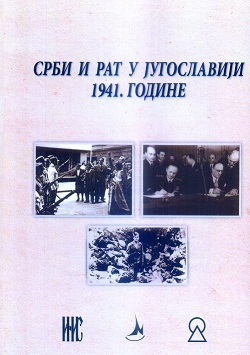Миграције становништва Војводине уочи и почетком Другог светског рата
Migration of Population in Vojvodina Shortly Before World War II
Author(s): Željko Bjeljac, Marija Drobnjaković, Milan Radovanović
Subject(s): Civil Society, Social history, WW II and following years (1940 - 1949), Migration Studies, Sociology of Politics, Peace and Conflict Studies
Published by: Institut za noviju istoriju Srbije
Keywords: Vojvodina; migrations; colonization; WWII; 1941;
Summary/Abstract: Subject of research work related to reconstruction activities in migration processes on demographic development in the territory of Vojvodina, which is traditionally the immigration area and a region with highly heterogeneous ethnic composition of the population. The time period that is treated refers to the end of the 30’s and 1941, including the results of colonization between the two world wars, 1919–1931. Results of the census of 1921 аnd 1931 indicate a population increase in compensating the period after World War II. This period is characterized by planning and settlement of population in relation to agrarian reform started in the 1919. The cause of this immigration was the peace treaty between the Kingdom of Serbs, Croats and Slovenes, and Hungary entered into Trijanonu 1920. According to estimates of the number of colonists to the area of today’s Vojvodina in the period of 1919–1929 inhabited 20,000 families (100,000 colonists). At the beginning of the Second World War Vojvodina was divided into three administrative-territorial totality: Backa was attached to Hungary, Srem was annexed by so-called Independent State of Croatia, Banat was under the direct administration of German military. Based on the memorandum of the Hungarian government in April 1941 on the most important tasks to be solved in the re-conquered the southern end, terminating the agrarian reform carried out in Backa and the land becomes the property of the Hungarian state, including the expulsion of Serbian population populated since 1919–1930 in Serbia and concentration camps Sharvar, Nagykanjiza and Barcs. (expelled around 56,000 people and over 10,000 Sebian colonists and the Jews were taken to camps). In the villages from which they were expelled Serbs occupied the 15,593 Hungarians from Bukovina and Transylvania, and 1681 from Bosnia. From Srem is in 1941 to Serbia expelled about 50,000 Serbs. According Poll Committee of the Assembly of AP Vojvodina, ,,Truth about events in Vojvodina during the 1941–1948“ has killed 70,890 people as civil victims (42,106 victims of Serbian nationality, or 59.40%). On 1941, was 7,813 civilian victims of war and Serbian victims of the prevailing (4,832) and Jewish ethnicity (2,274).
Book: Срби и рат у Југославији 1941. године
- Page Range: 103-118
- Page Count: 16
- Publication Year: 2014
- Language: Serbian
- Content File-PDF

